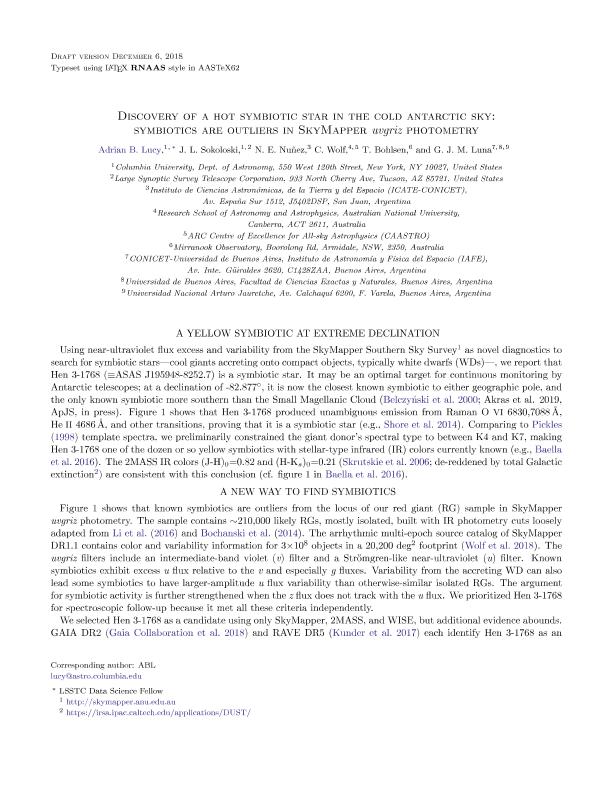Artículo
Discovery of a Hot Symbiotic Star in the Cold Antarctic Sky: Symbiotics Are Outliers in SkyMapper uvgriz Photometry
Lucy, Adrian B.; Sokoloski, J. L.; Nuñez, Natalia Edith ; Wolf, C.; Bohlsen, T.; Luna, Gerardo Juan Manuel
; Wolf, C.; Bohlsen, T.; Luna, Gerardo Juan Manuel
 ; Wolf, C.; Bohlsen, T.; Luna, Gerardo Juan Manuel
; Wolf, C.; Bohlsen, T.; Luna, Gerardo Juan Manuel
Fecha de publicación:
12/2018
Editorial:
IOP
Revista:
Research Notes of the AAS
ISSN:
2515-5172
Idioma:
Inglés
Tipo de recurso:
Artículo publicado
Clasificación temática:
Resumen
Using near-ultraviolet flux excess and variability from the SkyMapper Southern Sky Survey11 as novel diagnostics to search for symbiotic stars?cool giants accreting onto compact objects, typically white dwarfs (WDs), we report that Hen 3-1768 (≡ASAS J195948?8252.7) is a symbiotic star. It may be an optimal target for continuous monitoring by Antarctic telescopes; at a decl. of −82877, it is now the closest known symbiotic to either geographic pole, and the only known symbiotic more southern than the Small Magellanic Cloud (Belczyński et al. 2000; Akras et al. 2019, ApJS, in press). Figure 1 shows that Hen 3-1768 produced unambiguous emission from Raman O vi 6830,7088 Å, He ii 4686 Å, and other transitions, proving that it is a symbiotic star (e.g., Shore et al. 2014). Comparing to Pickles (1998) template spectra, we preliminarily constrained the giant donor´s spectral type to between K4 and K7, making Hen 3-1768 one of the dozen or so yellow symbiotics with stellar-type infrared (IR) colors currently known (e.g., Baella et al. 2016). The 2MASS IR colors (J − H)0 = 0.82 and (H − Ks)0 = 0.21 (Skrutskie et al. 2006; de-reddened by total Galactic extinction12 ) are consistent with this conclusion (see Figure 1 in Baella et al. 2016).
Palabras clave:
Symbiotic
,
Skymapper
Archivos asociados
Licencia
Identificadores
Colecciones
Articulos(IAFE)
Articulos de INST.DE ASTRONOMIA Y FISICA DEL ESPACIO(I)
Articulos de INST.DE ASTRONOMIA Y FISICA DEL ESPACIO(I)
Articulos(ICATE)
Articulos de INST.D/CS ASTRONOMICAS D/LA TIERRA Y DEL ESPACIO
Articulos de INST.D/CS ASTRONOMICAS D/LA TIERRA Y DEL ESPACIO
Citación
Lucy, Adrian B.; Sokoloski, J. L.; Nuñez, Natalia Edith; Wolf, C.; Bohlsen, T.; et al.; Discovery of a Hot Symbiotic Star in the Cold Antarctic Sky: Symbiotics Are Outliers in SkyMapper uvgriz Photometry; IOP; Research Notes of the AAS; 2; 4; 12-2018; 1-4
Compartir
Altmétricas



